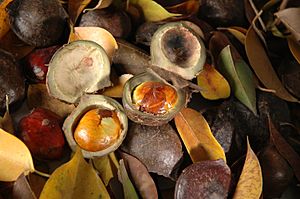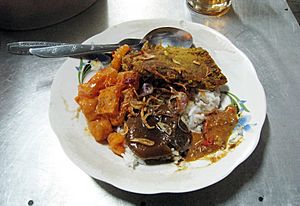Djenkol facts for kids
Quick facts for kids Djenkol |
|
|---|---|
 |
|
| Scientific classification | |
| Synonyms | |
|
Archidendron pauciflorum, often called djenkol, jengkol, or jering, is a type of flowering tree. It belongs to the pea family, known as Fabaceae. This tree grows naturally in Southeast Asia. Its seeds are a very popular food there.
People in countries like Thailand, Malaysia, Myanmar, and Indonesia enjoy these seeds. They prepare them by frying, boiling, or roasting. Sometimes, they even eat them raw. The beans contain a small amount of a substance called djenkolic acid. This can cause a mild illness called djenkol bean poisoning if too many are eaten raw or improperly prepared.
Besides food, the beans and leaves of the djenkol tree have been used in traditional medicine. People believed they could help purify blood. Today, you can usually find djenkol beans only in local markets.
Contents
What are its other names?
This plant has many common names because it grows in different countries. In English, some names are blackbead, dog fruit, djenkol tree, luk nieng tree, and ngapi nut.
In Indonesia, people call it djenkol tree, jinkol, jarung (in Sumatra), or jering (in Java). It's known as krakos in Cambodia and jering in Malaysia and Thailand. Other Thai names include luk nieng, cha niang, khang daeng, and pha niang. In Myanmar, it's called da-nyin-thee or da-nyin-pen.
What does the Djenkol tree look like?
The Archidendron pauciflorum is a legume tree that can grow quite tall, reaching 18 to 25 meters (about 60 to 80 feet). It has a wide, spreading top and smooth, grayish bark. Its leaves are bipinnate, meaning they have many small leaflets, and can be up to 25 cm (10 inches) long. Young leaves are a beautiful wine-red color and can be eaten.
This tree usually flowers between September and January. Its flowers are white and cup-shaped, with yellowish-white stamens.
The fruit of the djenkol tree is a woody, smooth, deep purple pod. Each pod holds about three to nine round seeds. The pods are often curved or twisted in a spiral shape. When young, the seed coat is yellow-green. As the fruit ripens, it turns dark brown. The ripe fruit then naturally splits open to release the seeds.
Where does the Djenkol tree grow?
The djenkol tree is native to Southeast Asia. It grows in primary (very old) and secondary forests. You can find it in humid, hilly, and flat areas, as well as along river banks. It grows from sea-level up to 1600 meters (about 5,250 feet) high. Countries where it thrives include Bangladesh, Indonesia (Sumatra, Sulawesi, Kalimantan), Malaysia, Myanmar, and Southern Thailand.
Djenkol trees grow best in well-drained sandy or lateritic soils. They also need a lot of rainfall to grow well.
How are Djenkol beans used?
Djenkol as food
What's in Djenkol beans?
Djenkol beans have about 26% carbohydrates. This is less than other common legumes like cowpea or kidney bean, which have about 60-70%. However, their protein content is around 14.2%. This is higher than many common cereals like wheat (13%) or rice (7%). People like djenkol beans because they have good protein and low fat.
How are Djenkol beans prepared?
Djenkol beans are usually 3.0 to 3.5 cm (about 1.2 to 1.4 inches) wide and 1.5 to 2.0 cm (about 0.6 to 0.8 inches) thick. They have a reddish-brown color. People prepare these beans by frying, boiling, or roasting. They are also eaten raw. They are a main food in Thailand, Malaysia, Myanmar, and Indonesia.
The seeds are mostly used to add flavor to food. However, when crushed, they can have a mild sulfur-like smell that some people find strong. Young seeds are often eaten raw as a type of salad called ulam. Mature seeds are prepared in different ways:
- They can be boiled thoroughly until the strong smell goes away. Then, they are eaten with salt and grated coconut.
- They can be soaked in salted water for a few hours, then fried in oil. This also helps reduce the strong smell.
- The seeds can be buried for about 14 days until they start to germinate (sprout). Then, they are dug up and eaten after the sprout is removed. This method is believed to make the beans safer to eat by reducing the risk of djenkol bean poisoning.
Djenkol in traditional medicine
Different parts of the djenkol tree are used in traditional medicine in Southeast Asia. Raw seeds were thought to help purify the blood or cure dysentery. People used compresses made from young leaves for skin problems. Burnt old leaves were believed to relieve itchy feelings. The powder from burnt young leaves was applied to cuts and wounds.
Other uses for Djenkol
Archidendron pauciflorum can also be used for dyeing. The pods of the seeds can dye silk purple, and the bark of the tree can dye things black. The shell of the seed is also used for washing hair. The wood from the tree is used as firewood and for building, such as making coffins. Because the seeds contain djenkolic acid, raw djenkol seeds are also used to make organic pesticides. They are combined with other plants to help kill and prevent pests.
How is Djenkol grown?
How Djenkol trees are planted
Sometimes, when primary or secondary rain forests are cut down, djenkol trees are left standing. If planted, they are usually spaced 10–15 meters (about 33-50 feet) apart. The plant prefers sandy, lateritic, or sandy clay soil that drains well. Djenkol trees are grown from seeds. Scientists haven't found good ways to clone them yet. In nature, squirrels, like the Callosciurus notatus, eat the seeds and help spread them.
Harvesting and storing Djenkol
One djenkol tree can produce between 1000 and 4000 seeds each year. In Java, the main harvest time is around July to August, with a smaller harvest from December to February. Djenkol is usually sold in markets by the number of seeds. For transport, especially young seeds, it's best to keep them in their pods. This stops them from drying out.
One way to store the seeds is by making them into chips, called emping. Another way could be to process them into flour. However, because the seeds have a lot of moisture, making flour from them is not very common right now.
Pests and diseases of Djenkol
Archidendron pauciflorum can be affected by some pests that also bother other legume trees and shrubs. These include pod-borers like Mussidia pectinicornella and Cryptophlebia ombrodelta. Also, caterpillars of the leaf-feeder Eurema blanda, a common butterfly in Java, can feed on its leaves.


